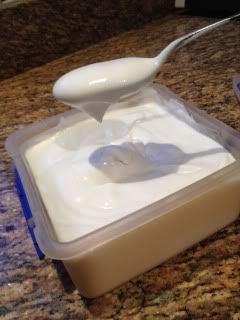A few months ago I jumped onboard the coconut yoghurt bandwagon to see what all the fuss was about. Coconut yoghurt fills a void for those with dairy and soy allergies in addition to the coconut fanatics out there. However, I was absolutely gobsmacked by the price! Given how cheap coconut cream/milk is, I don't understand why the commercial coconut yoghurts cost upwards of $10 for a 400g tub.
After trying a tub of one of the more popular brands and seeing that there were only 5 ingredients - coconut milk, tapioca, pectin, xylitol, culture; I figured that I could probably make it myself for a fraction of the price.
It is very creamy and goes beautifully with fresh fruit however after a couple of spoonfuls I was done as it is so rich!
Bear in mind that this is no yoghurt alternative - the nutritional profile is completely different. There is no calcium, barely any protein and more than triple the fat and saturated fat in coconut yoghurt. Maybe a healthier double cream alternative?
Per 100g
|
Coconut Yoghurt
|
Full Fat Natural Yoghurt
|
Chobani 0%
|
Energy
|
866kj
|
370kj
|
251kj
|
Protein
|
1.5g
|
6g
|
10.2g
|
Fat
|
19.3g
|
4.5g
|
0g
|
Saturated Fat
|
17.3g
|
2.7g
|
0g
|
Carbohydrate
|
7g
|
5g
|
4.2g
|
Calcium
|
-
|
195mg
|
114mg
|
I've made coconut yoghurt a couple of times now, twice with tapioca and once with cornflour. I've found both to work perfectly. The yoghurt continues to thicken each day in the refrigerator (see photos below.) Here is my cornflour version.
Coconut Yoghurt
3 x 400g tins coconut cream (60% coconut - check the ingredients label)
2 tbsp cornflour (or tapioca starch)
1 tbsp rice malt syrup
1/4 tsp probiotic starter
1. In a cup, place 3 tbsp coconut cream. Add cornflour and stir to create a slurry.
2. Place the remainder of the coconut cream and rice malt syrup in a medium saucepan and whisk in the cornflour slurry.
3. Heat on a medium heat, whisking continuously until the mixture boils and thickens to the same consistency as runny custard.
4. Leave to cool until it reaches 40 degrees.
5. Once at 40 degrees, remove the skin that has formed and discard, then stir in the probiotics.
6. Pour into a yoghurt maker or thermos and keep at 37-40 degrees for 12-24 hours. (I kept mine for 24 hours)
7. Remove the crusty top (this only happens with cornflour, not tapioca) and pour into container and leave in the fridge for a couple of days to thicken further. The photo above is the consistency on day 3.
8. Enjoy!
 |
| The icky skin! |
 |
| Day 1 - Fairly runny |
 |
| Day 2 - Getting thicker |
